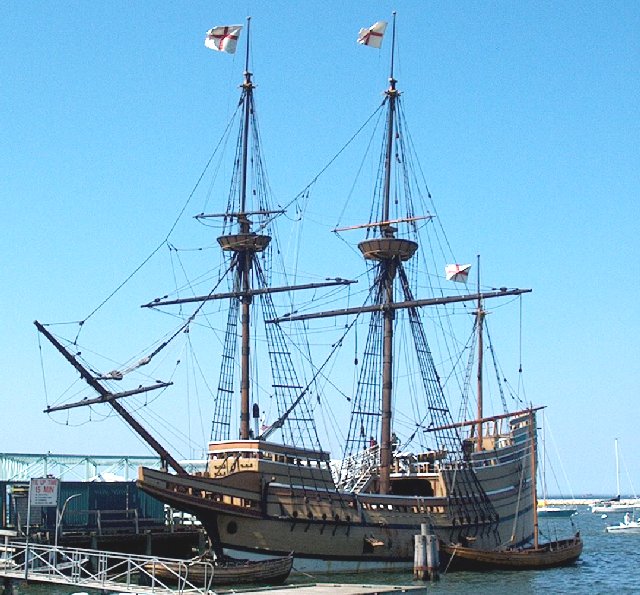The Mayflower was a Dutch cargo fluyt that weighed 180 tons and measured 110 feet long. It had four decks (main, gun, cargo) and three masts. Square-rigged and beak-bowed, it had castle-like structures at its fore and aft, making progress slow against the prevailing winds. Hence, the trip from England to America took over two months to complete.
Master Christopher Jones planned out the route of the Mayflower. The ship first disembarked in July of 1620 filled with 135 people, both passengers and crew. Many of the passengers were Separatists, wanting to separate from the Church of England. However, hired hands and indentured servants were also on board, including four young children (long before the British Home Children came to Canada).
The Mayflower met up with another ship, the Speedwell, which sprang a leak and was abandonned, its passengers joining those on the Mayflower. In September 1620, the ship disembarked from Plymouth, England to sail to the New World. Its cargo deck held cannon, shot and gunpowder, just in case pirates were lurking in the Atlantic. Its cargo hold held live sheep, poultry, pigs and goats along with food and supplies. Its captain navigated using a compass and kept time with an hourglass.
With the voyage taking longer than expected, the food supply grew low. Rather than risking drinking the untreated water, most drank beer on board the ship (although that seems hard to believe in case of the Puritans on board). To entertain themselves, passengers played cards like Nine Men's Morris. Winds were strong resulting in many cases of seasickness. Miraculously, only two deaths were reported on the voyage.
The Pilgrims' planned destination was the Virginia Colony. However, in November 1620, with the winter approaching, they decided to dock at Provincetown, Massachusetts on Cape Cod. There, after stealing corn and getting in a skirmish with the Natives, they decided to flee. In December, they reached Plymouth. While still on board the ship, they signed the Mayflower Compact, a list of rules that they would follow in the new colony.
The first winter was cruel. The Pilgrims stayed on board the ship since they did not have dwellings to live in yet. In the closed quarters of the ship, scurvy, pneumonia and tuberculosis ran rampant. Half of the passengers and crew perished.
The following spring, the crew of the Mayflower returned to England, taking less than half the time thanks to the prevailing winds at their backs. That fall, the Pilgrims, thankful for their bountiful harvest, celebrated the first Thanksgiving. Three years later, the Mayflower was scrapped.
In 1956, a Mayflower II was built. It sailed to America the following spring, following a similar route to that of the original ship.. The Mayflower II docked at Plymouth, Massachusetts where it became a floating museum. In 1970, marking the 350th anniversary of the Pilgrim's landing, the ship was taken over by the Natives to protest their poor treatment. The issue was resolved and the Mayflower II still floats at Plymouth Rock.

Mayflower II courtesy http://en.wikipedia.org/wiki/Mayflower.
No comments:
Post a Comment